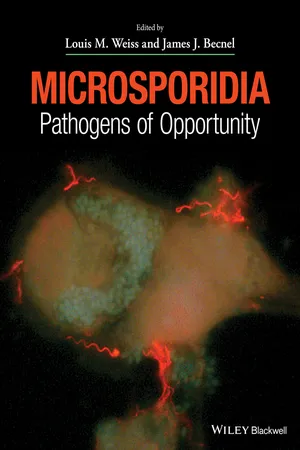1.1 INTRODUCTION
Microsporidia are intracellular parasites ranked among the protists, which means that they are eukaryotic and unicellular. The microsporidian cell exhibits, however, a number of unique features, some of them are reductions, and others are structural innovations. The main morphological characteristic of the microsporidia is the profound difference between multiplicative (vegetative) stages on one hand and disseminated spores (and their immediate precursors) on the other hand. Vegetative stages are rather inconspicuous cells showing several seemingly primitive characters: instead of typical mitochondria, they possess mitosomes, which are mitochondrial remnants (Williams et al. 2002; Vávra 2005), their Golgi apparatus is of an unstacked type (Vávra 1965, 1976a; Beznoussenko et al. 2007), their ribosomes are not of the typical eukaryotic type but resemble ribosomes of prokaryotic organisms (Ishihara & Hayashi 1968; Curgy et al. 1980), and the microsporidian cells lack typical microbody-like organelles (peroxisomes) (Vávra & Lukeš 2013). Microsporidian spores, on the other hand, are equipped with an infection apparatus, composed of a unique set of organelles, which during spore germination injects the spore content into a host cell and perpetuates thus the life cycle of the parasite (Lom & Vávra 1963a; Vávra 1976a; Weidner 1976a; Vávra & Lukeš 2013). Spores are the only stage that survives outside the host, and due to their durability and structural complexity, the spores are essential for microsporidium recognition and classification.
1.2 STRUCTURAL CHARACTERS AND CLASSIFICATION OF MICROSPORIDIA
Structural characters are still basic for microsporidian classification, despite that molecular biology characters are progressively gaining importance for revealing relationships between individual taxons of the phylum and between microsporidia and other organisms. Molecular biology also provides unique possibilities to identify developmental stages of microsporidia with complex life cycles comprising dissimilar life cycle stages (see Section 1.3.4).
The first microsporidium was described in 1857 (Nägeli 1857), and during the more than 150 years’ long history of formal existence, based on cytology, microsporidia have successively been classified as yeastlike fungi, protozoans of various taxonomic ranks, as well as Archezoa, primitive organisms from the premitochondrial era of eukaryotic cell genesis (see Corradi & Keeling 2009, for the history of microsporidia taxonomy). Recent views, however, consider microsporidia to be related to fungi. Microsporidia–Fungi relationship is supported almost exclusively by molecular biology data (see Chapter 5). The structural support for such relationships is inconclusive, being limited to a number of characters, like deposition of cell wall material on the plasma membrane of certain developmental stages, the structure of the spindle pole terminus, presence of chitin in spores, closed type of mitosis, presence of nuclear twins in some microsporidia, and some features of meiosis (Cavalier-Smith 2001; Thomarat et al. 2004). These characters which, however, are not quite fungi-specific (Vávra & Lukeš 2013) are discussed in detail in the following text.
The unique structural and biological characters of microsporidia justify their ranking as a phylum of their own, named Microspora Sprague, 1977, or Microsporidia Balbiani, 1882, depending on the interpretation of Balbiani’s intentions as it was not specified as a phylum (Balbiani 1882), within the superkingdom Opisthokonta (Adl et al. 2012). However, microsporidia lack a posteriorly directed flagellum, which is a characteristic of the Opisthokonta, and they have no 9 + 2 microtubular structures in their cells. In this character, microsporidia resemble fungi which have lost flagella almost totally (James et al. 2006; Liu et al. 2006).
By tradition, names, descriptions, and type requirements of new microsporidian taxa follow the rules of the International Code of Zoological Nomenclature (ICZN 1999). It has been recommended that this practice is maintained even if microsporidia at present time are believed to be related to the kingdom Fungi which are treated under the botanical code ICBN (Redhead et al. 2009). The last census of microsporidian genera is that of Larsson (1999), Sprague et al. (1992), and Canning and Vávra (2000), with the paper by Larsson (1999) providing extensive information on structural characters of microsporidian genera described up to the year 1999. As about 43 genera have been added since 1999, presently, there exist about 197 genera (see Appendix 1) and totally 1300–1500 microsporidian species (Vávra & Lukeš 2013). As stated earlier, the comprehensive classifications of microsporidia have mostly been based on structural characters, and several classifications below the phylum level exist (Sprague 1977; Weiser 1977; Issi 1986). The classifications based mostly on other characters than morphology have the limitation that they cover only part of existing genera (Sprague et al. 1992; Vossbrinck & Debrunner-Vossbrinck 2005).
Although microsporidia structurally are a very homogeneous group of organisms, nevertheless, two main branches, conspicuously differing in structure and development, can be recognized. The groups are the typical microsporidia and the supposedly evolutionary primitive (or reduced?) atypical microsporidia. The last group can be divided into two structurally diverse subgroups.
Microsporidia with a cytology typical for these protists are by far the largest group, with more than 1000 named species in nearly 190 genera. Their hosts are found in all groups of animals, from protists to humans. They exhibit the most complex life cycles and produce spores in a great variety of shapes, from spherical to rodlike.
Life cycle and cytology distinguish typical microsporidia from the other two groups: chytridiopsids and metchnikovellideans. Our knowledge of these groups is superficial. The two groups share an extrusion apparatus of similar, although not identical, construction that diverges from the common type of extrusion apparatus. They also share a life cycle that differs from that of typical microsporidia. Whether these similarities indicate that the two groups are closely related is unknown. The chytridiopsids, represented by about 15 species in 8 genera, are parasites of terrestrial or freshwater invertebrates, mostly insects. Their spores are spherical. The metchnikovellideans (about 25 sp...
